Vol 4 No. 31 TROPIC LIGHTNING NEWS August 4, 1969
Index
| Unit Page | Unit Page | Unit Page | Unit Page |
| 1/5 1 | 2/27 8 | 2nd Bde FAC 4-5 | 4/9 1 |
| 187 AHC 1 | 2/27 Photo 8 | 2nd Bde Photos 4-5 | 4/9 6 |
| 2/12 1 | 2/34 8 | 3/4 Cav 8 | 4/9 Photos 7 |
| 2/14 1 | 2/34 Photo 3 | 3rd Bde 8 | 4/9 7 |
| 2/14 Photo 1 | 2/77 Arty 6 | 4/23 6 | |
| 2/27 3 | 2nd Bde 3 | 4/23 Photos 6 |
Bobcats,
Dragons Work Together; VC Die Together
By SGT JAN ANDERSON
Cu Chi - Following a
well-rehearsed schedule to the minute, the operations section of the 1st
Battalion (Mechanized), 5th Infantry, in a joint effort with the 2d
Battalion, 14th Infantry, struck with swiftness in an early evening
raid on what appeared to be an enemy "stand-down" area. Forty-seven enemy died.
Acting on information
supplied by a suspect detained earlier in the day, the Bobcat operations section
devised a plan that would entirely destroy what was reported to be a regular
meeting and rest area for both Viet Cong and North Vietnamese troops at the edge
of the Ho Bo Woods, seven miles northwest of Cu Chi.
According to the informant,
20 to 25 enemy moved into the camp, which included two hootches for eating,
sleeping and exchanging strategic information.
The area was in use, the suspect claimed, between 5 and 6 p.m. each
night.
Throughout the afternoon,
flights over the region began to result in a minute-by-minute plan that was to
be a success.
5:30 p.m.: 1/5th operations command-and-control ship lifts
off from Fire Support Base Devins with Bobcat Battalion Commander Lieutenant
Colonel Robert A. Kurek of Phoenix, Ariz., and Operations Officer Major Ronald
Baker of Rapid City, S.D..
5:45 p.m.: A nine-ship lift from the 187th Assault Helicopter
Company goes airborne after loading Bravo Company, 2d Battalion, 14th
Infantry at Fire Support Base Patton.
5:54 p.m.: With the 2/14th Golden Dragons eagle flight in the
air, the Bobcat C-and-C ship co-ordinates the entire mission.
Two Cobra gunships roll onto the target area, and in one pass expend
their entire ordnance on the two hootches.
5:56 p.m.: A four-minute prep of artillery begins as the eagle
flight starts its descent. The
ships are scheduled to touch down at 6:00 p.m.
The C-and-C shop spots several groups of three to five enemy scattering
in helter-skelter movement.
6:00-7:00 p.m.:
Ground troops continue to search the area, finding bodies and detaining
suspects.
7:15 p.m.: Twelve detainees picked up by the 2d Battalion, 14th
Infantry, are loaded into helicopters.
7:17 p.m.: Company B of the Golden Dragons loads up for the return
flight to Patton, mission accomplished.
The operation went precisely
as planned. Co-ordination and
rehearsal paid off.
After the completion of the
mission, Baker commented, "Through maximum pre-planning, we were able to
attain the kind of co-ordination between units involved necessary for so
successful a result."
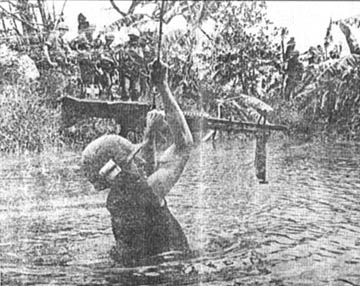 Lieutenant Colonel
Constantine Blastos, commanding officer of the Golden Dragons from Leavenworth,
Kan., said, "The timing and co-ordination of the battle were classic in that
all elements, artillery, gunships and infantry, worked together flawlessly."
Lieutenant Colonel
Constantine Blastos, commanding officer of the Golden Dragons from Leavenworth,
Kan., said, "The timing and co-ordination of the battle were classic in that
all elements, artillery, gunships and infantry, worked together flawlessly."
Measuring success in
statistics, the operation resulted in 47 enemy killed, plus ten B-40 rocket
launchers, one light machinegun, 17 AK-47 assault rifles and two K-54 pistols
captured. A sweep of the same area
the following day uncovered several documents, 20 pounds of medical supplies and
ten pounds of clothing.
SLUNG HIGH AND DRY on a "D" ring, an M-60
manned by Wolfhound gunner, Specialist 4 Thomas Coyne of Sandusky, Ohio, makes
its way safely across a 25-meter inlet of the Oriental river.
(Photo by PFC
CRAIG SAMPSON)
10 VC Fall to 2/12
By SP4 ART BROWN
Cu Chi - A platoon from
Delta Company, 2d Battalion, 12th Infantry Warriors, met head on with
an unknown-size enemy force northwest of Cu Chi recently and killed ten enemy
without suffering any casualties.
"I saw three VC running
from a hootch to a bunker," said PFC John Harrington of West Springfield,
Mass. "I opened fire, wounding
one of them. But all three made it
into the bunker."
During the exchange of fire,
the acting platoon leader, Staff Sergeant Larry Poole of Columbus, Ohio, called
in support from his own 81mm mortars. "They
reacted very quickly and were on target with the first rounds.
During the mortar barrage I had cobra gunships on the way.
They continued blasting the enemy," said Poole.
"Just before we moved in
the second time, we used LAWs on the closer bunkers," related Private First
Class Bill Teasuro of Patterson, N.J.
With another platoon set up
in a blocking position, the soldiers moved in and through the enemy positions.
Found in the search were an
AK-47 rifle, a .45 caliber pistol, five rifle grenades, two VC back packs, an
SKS rifle, a B-41 rocket launcher and a half-pound of enemy documents.
NVA Recon Capt. Killed
By PFC RICHARD SEARS
Tay Ninh - A captain of
the Recon Company of the 88th NVA Regiment was killed by Alpha and
Delta Company of the 4th Battalion, 9th Infantry Manchus
on the chopper pad near Fire Support Base Sedgwick II.
Movement was spotted just
after midnight. A small group of
NVA were first seen by men on a listening post outside the wire.
Immediately the news was called into the company command post and the men
were told to come inside the wire.
After all LP personnel were
safely in the wire, 81mm mortars and small arms fire ripped apart the still
night air. A blanket of accurate
fire was laid down in the area where movement had been spotted.
After it was lifted, there was no more visible movement for the remainder
of the night.
The next morning, two bodies
were found on the chopper pad, about 300 meters from the last wire.
One body was identified by papers he carried as a captain of the Recon
Company of the 88th NVA Regiment.
Other papers were found in
the captain's possession, including maps and diagrams of the location and
layout of Sedgwick II and also of the nearby village of Ben Cau with its ARVN
compound.
Battalion Commander
Lieutenant Colonel John R. Randolph of Columbus, Ga., commented on the action:
"I believe the entire Recon Company was sent out to explore the area
for a larger group of NVA which was dug in in the Renegade Woods."
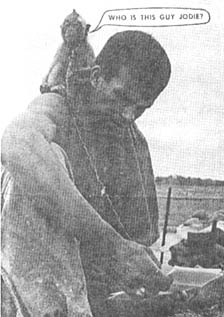 |
UNCAGED KIBITZER - Tony, pet monkey of Bravo Company, 2d Battalion, 14th Infantry, gathers in all the information as he reads over the shoulder of Specialist 4 William Petruik of Edmonton, Alberta, Canada. The letter is being pondered by the two Golden Dragons at Fire Support Base Patton. (Photo by SP4 KARL KARLGAARD) |
Page 2 TROPIC LIGHTNING NEWS August 4, 1969
Decorated
| DISTINGUISHED FLYING CROSS | |
| LTC Carl M. Mott,
Jr., 7th Bn, 11th Arty W01 James A. Derck, HHC, 2d Bde WO1 Steven J. Zorger, D Trp, 3d Sqdn, 4th Cav |
CSM Charles M.
Rutledge, HHC, 2d Bn, 14th Inf PFC Jeffery R. Fox, B Trp, 3d Sqdn, 4th Cav |
SILVER STAR |
|
| LTC Robert J.
McGowan, HHT, 3d Sqdn, 4th Cav (2d and 3d Oak Leaf Cluster) LTC Constantine J. Blastos, HHC, 2d Bn, 14th Inf MAJ William T. McNamara, HHC, 3d Bn, 22d Inf MAJ Joseph E. Galle, HHS Btry, Div Arty CPT John K. Taft, Co D, 2d Bn, 12th Inf CPT Mnnfred H. Stibbe, Co B, 2d Bn, 12th Inf 1LT William Bradley, HHC, 4th Bn, 23d Inf 1LT Patrick J. Madison, Co B, 4th Bn, 23d Inf 1LT Alfred S. Aldrick, Co A, 3d Bn, 22d Inf 1LT Kenneth D. Nelson, HHC, 4th Bn, 23d Inf 1LT Edward L. Bruton, HHC, 2dn, 34th Armor CSM Robert G. Adams, HHC, 3d Bn, 22d Inf SSG Leonard Simpson, Co B, 4th Bn, 9th Inf |
SP6 William J.
Myers, HHC, 3d Bn, 22d Inf SGT Patrick Tobin, Co C, 1st Bn, 27th Inf SGT Fred Ogas, Jr., C Trp, 3d Sqdn, 4th Cav SGT Richard L. Hudson, Co C, 4th Bn, 9th Inf SP5 Otis L. Wilson, Co B, 4th Bn, 23d Inf SP4 Thomas J. Lyons, Co D, 1st Bn (M), 5th Inf SP4 Jeffrey Condti, Co C, 2d Bn, 22d Inf SP4 Daniel E. Latshaw, Co D, 2d Bn, 12th Inf SP4 Phillip F. Kraffert, HHS Btry, 7th Bn, 11th Arty SP4 Stephen E. Wolf, 341st ASD SP4 Richard E. Muenz, Co A, 25th Avn Bn SP4 Lester T. Beard, Co C, 4th Bn, 23d Inf SP4 Maurice E. Arvon, Co A, 25th Avn Bn SP4 Edward R. Salazar, Co E, 2d Bn, 12th Inf |
BRONZE STAR FOR HEROISM |
|
| LTC Edward C.
Gibson, HHC, 65th Engr Bn CPT Kenneth E. Lancaster, HHS Btry, 7th Bn, 11th Arty CPT David A. Zamory, B Btry, 1st Bn, 8th Arty CPT. H. D. Neal, A Btry, 7th 11th Arty CPT Edward A. Smith, HHS Btry, 7th Bn, 11th Arty CPT Paul F. Allen, HHC, 2d Bn, 12th Inf CPT Arthtur L. Van Houten, HHC, 3d Bn, 22d Inf 1LT Charles J. Pruitt, B Trp, 3d Sqdn, 4th Cav 1LT Stuart J. Greene, B Btry, 1st Bn, 8th Arty 1LT William M. Barnes, Co B, 4th Bn, 9th Inf 1LT James H. Bridges, HHC, 3d Bn, 22d Inf 1LT Frank H. Robbins, JR., Co A, 3d Bn, 22d Inf 1LT Wilbur D. Saulters, Co B, 4th Bn, 9th Inf 1LT James R. Donbrowski, HHS Btry, 11th Arty 1LT Robert E. Tripp, Co A, 3d Bn, 22d Inf 1LT Thomas Deutschlander, Co A, 2d Bn, 14th Inf 1LT Jeffery S. Babb, C Trp, 3d Sqdn, 4th Cav 1LT George M. Norrie, B Trp, 3d Sqdn, 4th Cav 1LT William D. Watson, HHS, 1st Bn, 8th Arty 1LT Homer G. Adams, C Trp, 3d Sqdn, 4th Cav 1LT James C. Trebilcock, Co B, 3d Bn, 22d Inf 1LT Don L. Smith, A Btry, 7th Bn, 11th Arty 1LT Michael T. Opie, C Trp, 3d Sqdn, 4th Cav |
2LT Fredrick H.
King, HHS Btry, 1st Bn, 8th Arty 2LT David R. Prasuhn, C Btry, 2d Bn, 77th Arty 2LT John R. Knox, Co C. 4th Bn. 23d Inf 1SG James E. Wirt, A Btry, 7th Bn, 11th Arty 1SG William C. Logan, B Btry, 1st Bn, 8th Arty SFC Gregorio Mireles, A Btry, 7th Bn, 11th Arty SFC Marvin P. Rothrock, A Btry, 7th Bn, 11th Arty PSG John J. Weiss, C Trp, 3d Sqdn, 4th Cav SSG Bobby L. Sturgill, Co E, 2d Bn, 12th Inf SSG Charles E. Martin, A Trp, 3d Sqdn, 4th Cav SSG Reyes Alanis, Co A, 2d Bn, 34th Armor SSG Wesley L. Elam, Co B, 4th Bn, 23d Inf SSG Dickie L. Tidwell, B Trp, 3d Sqdn, 4th Cav SSG Charles B. Gerry, Co C, 4th Bn, 23d Inf SGT Leonard Gonzales, Jr, C Trp, 4th Cav SGT Anthony R. Camelio, D Trp, 3d Sqdn, 4th Cav SGT Dwyn Welch, Co C, 1st Bn, 5th Inf SGT Charles C. Fleek, Co C, 1st Bn, 27th Inf SGT James M. Harthcock, B Btry, 1st Bn, 8th Arty SGT Sidney L. Kendrick, A Btry, 7th Bn, 11th Arty SGT Randall Osborne, C Trp, 3 Sqdn, 4th Cav SGT David P. Korpal, Co E, 2d Bn, 12th Inf SGT Jesse Uptigrove, Co A, 1st Bn, 5th Inf |
Tax Free - Think About It
Medic Gets $10,000 for 6
CU CHI—At recent
ceremonies at the 25th Division's Reenlistment Office, a medic from Company D,
2d Battalion, 34th Armor, received a $10,000 variable re-enlistment bonus.
Major General Ellis W. Williamson presented Specialist 5 Dennis Byron
Shelley the highest re-enlistment bonus possible.
Specialist Shelley, whose
home is in Stockville, Neb., was the first man in the 2/34 Armor to receive the
full $10,000 on his VRB.
Dreadnaught Re-enlistment
NCO SFC Gerald D. Marlowe, a recent arrival in Vietnam, performed his first
duties by aiding Shelley. "I was
very pleased to be able to help Specialist Shelley," said Marlowe. "He is a sharp young man and has carefully planned his
future."
Marlowe was then asked how a
person obtains the highest possible VRB. "Two
factors played important roles in Shelley's getting the $10,000 VRB for a six
year re-enlistment. The first is
that Shelley is a medic and has a critically needed MOS. Secondly, Specialist Shelley had been in the National Guard
prior to coming on active duty. Naturally,
the Guard time was computed as part of Shelley's total time in the Army, and
thus boosted his basic pay scale rate - the heart of the VRB scale."
The end result is Shelley
now has the station of his choice and $10,000 tax free.
Captain Robert J. Guerra,
the Dreadnaughts' Medical Officer, relies on Shelley to act as one of the two
medical section sergeants. Says
Guerra, "Shelley is a 91C20 and has had special medical training, almost a
year more than the average medic. His
additional training at Letterman General Hospital in San Francisco makes him
invaluable, both in the field and at the battalion aid station. Shelley is a definite asset to the battalion's medical
services section.
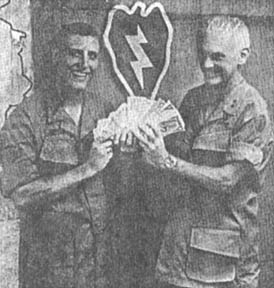 Shelley has planned an
industrious project for his coming second tour of duty in the Army.
"I'm planning on furthering my college education toward a medical
degree. I hope to do this both
through stateside schools and through Army Correspondence courses.
My daily experiences in my field of work will also be a big help in my
future goals. Possibly, later on, I
would like to go to Officer Candidate School and earn my commission." For "Doc" Shelley, the future looks very rich indeed.
Shelley has planned an
industrious project for his coming second tour of duty in the Army.
"I'm planning on furthering my college education toward a medical
degree. I hope to do this both
through stateside schools and through Army Correspondence courses.
My daily experiences in my field of work will also be a big help in my
future goals. Possibly, later on, I
would like to go to Officer Candidate School and earn my commission." For "Doc" Shelley, the future looks very rich indeed.
HOW DOES IT FEEL? - Maybe you could find out.
Specialist 5 Dennis Byron Shelley found out how $10,000 felt by
re-enlisting for six years. Major General Ellis W. Williamson presented the 10 Gs to the
beaming medic. Why not check with
your re-up officer? There's
probably a substantial VRB waiting for you.
(PHOTO BY SP4 HARRY ANDERSON)
Army Takes Care of Its Own
The 1969 Joint Annual Fund
Campaign of the Army Emergency Relief (AER)
and Army Relief Society (ARS) is being conducted throughout the United States
Army.
The purpose of the
jointly-operated AER and ARS is to aid Army families during financial
emergencies.
Each year voluntary
contributions are sought from members of the Army, thus giving rise to the
AER-ARS slogan "The Army Takes Care of Its Own."
Last year's contributions enabled assistance totaling almost $5.5
million to be extended to 42,018 Army families.
All members of the Army,
both active and retired, and members of their families are eligible for AER
assistance.
When an emergency arises for
which financial aid is needed, one may apply as follows:
(1) If you live on an Army
post, first discuss the problem with your company commander, and then contact
the post AER Officer. (He's listed in the post telephone directory.)
(2) If you live in a
civilian community, apply through the local Red Cross chapter for AER
assistance, or apply direct to an AER Officer at the nearest Army post.
(3) When the sponsor is not
present, dependents living on an Army post should apply to the AER Officer: if
living in a civilian community, dependents may apply for AER help through the
local Red Cross chapter or the AER Officer at the nearest Army post.
ARS is a program to assist
needy widows and orphans of Regular Army personnel.
Eligible dependents seeking financial help or scholarships should contact
the local ARS representative, an AER officer, the local Red Cross chapter, or
apply direct to Army Relief Society Headquarters.
The TROPIC LIGHTNING NEWS is an authorized publication of the 25th Infantry Division. It is published weekly for all division units in the Republic of Vietnam by the Information Office, 25th Infantry Division, APO San Francisco 96225. Army News Features, Army Photo Features, Armed Forces Press Service and Armed Forces News Bureau material are used. Views and opinions expressed are not necessarily those of the Department of the Army. Printed in Tokyo, Japan, by Pacific Stars and Stripes.
MG Ellis W. Williamson . . . . Commanding General
MAJ John C. Fairbank . . . . . Information Officer
1LT John C. Burns . . . . . . . . Officer-in-Charge
SP5 Charles H. Withrow . . . Editor
SP4 David DeMauro. . . . . . . Assistant Editor
SP4 Ralph Novack . . . . . . . . Production Supervisor
BATTALION CORRESPONDENTS
| SGT
Jon Anderson SP4 Dennis Dibb SGT Roger Welt PFC John Frame PFC Sam Dixon SP4 K. C. Cullen SP4 Arthur Brown PFC Larry Goodson |
1/5 1/5 4/23 4/23 4/23 3/22 2/12 2/12 |
SP4 Pete Freeman PFC Richrard Sears SP4 Carl Detrick PFC Frankie Ditto PFC Victor Allison PFC Phil Jackson PFC Craig Sampson SP4 Pat Morrison |
7/11 4/9 2/34 2/14 3/4 2/27 2/27 3/13 |
Page 3 TROPIC LIGHTNING NEWS August 4, 1969
Offensive
Defense Is Secret of Cu Chi Security
CU CHI - Night is settling
over the 25th Infantry Division Base Camp at Cu Chi.
Tired soldiers are preparing for sleep, seeking long-awaited
entertainment, or sitting back with letters from home.
Suddenly, four 122mm rockets
scream up out of the surrounding countryside.
AT
THE 2D BRIGADE Tactical
Operations Center, an alert radio-telephone operator gets a call from Cu Chi
radar: incoming. The trajectory of
the rockets is quickly plotted. Coordinates
are sent down to the artillery batteries. Return
fire is set and ready to fall on the enemy even as the rockets slam inside the
perimeter.
Warning sirens are switched
on as the artillery begins to exercise its guns, and every man in Cu Chi takes
up his fighting position.
It is such a scene that most
Tropic Lightning soldiers imagine when they think about base camp defense.
But there is more to the complex system of keeping Cu Chi safe for men
and equipment than just the rapid reactions during a Red Alert.
"DEFENSE OF CU CHI
is an
'offensive' defense," said Lieutenant Colonel Donald O. Crutchley of
Bethesda, Md., 2d Brigade executive officer and base camp defense coordinator.
"Network our defense from the inside out.
From Cu Chi through the entire area of operations of the 25th Division,
we're out to keep the enemy moving and make him incapable of massing for, or
setting up, mortar or rocket launching positions."
At the core of this
intricate defense is the material fortification of Cu Chi itself. On the perimeter, where fields of fire have been cleared of
trees, shrubs and any kind of possible concealment, run strands of concertina
wire, rows of claymore mines, bunkers, fences, berms, and fighting positions.
The most sophisticated
fixtures on the bunker line are the artillery towers and observation stations.
Along with radar, visual surveillance from these points provides first
indication that an attack may be imminent.
TO AID IN
sightings, bunkers
and towers are equipped with starlight scopes, infrared sensing devices,
searchlights and telescopes. Manning
these positions day and night are guards from units permanently stationed in Cu
Chi.
Moreover, a complex net of
communications helps to verify any hint of enemy activity.
Constant rebuilding and
improvement keep the perimeter in top defensive condition.
New fences, searchlights and fighting berms are always under
construction.
Crutchley summarized the
process: "Building a defense for a base camp is like building a house.
Even though it may appear to be finished, it's actually a job of
continuous construction ."
Coupled with the sound
physical defenses are the firing techniques used to discourage Charlie from
sneaking close to Cu Chi. The
perimeter is divided into numerous sectors, each including several bunkers.
AT RANDOM BUT
predetermined
times sectors fire during the night a final protective line, a weapons test, or
a few claymore mines. "That is
just to keep anyone who may be out there off guard," said Crutchley.
"Of course, our weapons can respond immediately, to any positive
sightings."
Although firing along the
perimeter is tightly controlled, an officer in charge of a sector can order fire
on a position if a definite intrusion is confirmed.
Should an invader get inside any strand of wire, there is no time delay
waiting for permission. The enemy
is in immediate danger.
Additional power from
helicopter gunships and artillery is only seconds away through 2d Brigade
Tactical Operations Center and base camp defense.
IN THE EVENT
of a ground
attack, the internal defense system at Cu Chi allows for rapid reaction forces
and special squads of military police to be ready to reinforce the line defense.
Every man's position is part of a carefully drawn plan for "Red
Alert."
"But all of these
preparations," added Colonel Crutchley, "depend on alertness of men. We may have the best constructed bunker line in Vietnam.
But it means nothing if the men are not alert.
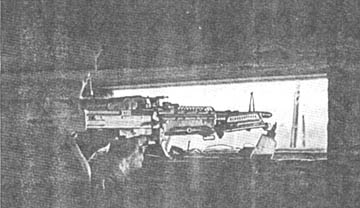 |
| ALERTNESS on the bunker line means staying close to your weapon and knowing your firing zone. Corporal Charles E. Black of Chattanooga, Tenn., scans the area for enemy activity. (PHOTO BY SP4 GARY SCIORTINO) |
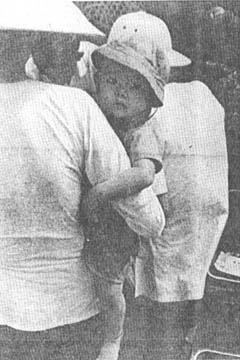 Wolfhounds, RFs Pull Joint MEDCAP
Wolfhounds, RFs Pull Joint MEDCAP
CU CHI - Twenty-fifth Infantry Division troopers and South Vietnamese forces
are working together to provide medical aide to needy villagers in the Duc Hoa
District. The operation is part of
a concerted pacification project to help areas once threatened strongly by the
Viet Cong.
The highly successful
program is to run by the Vietnamese with assistance from the 2d Battalion, 27th
Infantry Wolfhounds.
"We want to stress to the
villagers that their government is willing to protect them and offer medical and
nutritional aid," said the Wolfhound battalion commander, Lieutenant Colonel
Forest Rittgers, Jr., of Manlius, N.Y.
Before pacification teams
move into a village, allied forces cordon off the area to insure that no Viet
Cong are present. PSYOPS teams than inform the people that a government team
will be will be in the vicinity with doctors to treat the sick.
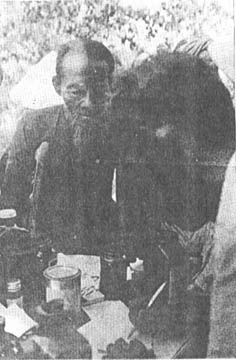 Once the people have
gathered in the aid station, an orientation is given by the District Chief of
Duc Hoa, explaining that the Saigon government is here to stay and is willing to
help them in any way possible.
Once the people have
gathered in the aid station, an orientation is given by the District Chief of
Duc Hoa, explaining that the Saigon government is here to stay and is willing to
help them in any way possible.
Captain Jerry Parks of Sioux
City, Iowa, Wolfhound S-5 officer, had this to say about the project:
"We are trying to make the villagers realize that they can depend on
their own government. These
projects give the locals the feeling that they are helping themselves without
relying upon a foreign element for support!
A total of 1,096 patients,
including 28 dental cases, have been treated by Wolfhound and Vietnamese medical
teams on two missions. Six thousand
pounds of rice have also been distributed to help the villagers.
"The MEDCAP program,"
stressed Parks, "is the most important part of pacification and the best way
to reach the people.
THE OLD AND YOUNG ALIKE
came to the Pagoda at An Dinh to receive medication from
2d Battalion, 27th Infantry, and Vietnamese Public Health Service
medical teams. The Tropic Lightning
troops along with Regional Force companies cordoned an insecure area 11 miles
west of Cu Chi, while the medical and pacification teams moved in.
(Photos by
PFC PHIL JACKSON)
|
The American Express Office that offers a free checking account is now
officially open in quarters of its own. The
office is located next to the Cu Chi PX area. Aside from paying 5 per cent on checking accounts, American Express offers many other services, including the sale of money orders and traveler's checks for R & R. |
Page 4-5 TROPIC LIGHTNING NEWS August 4, 1969
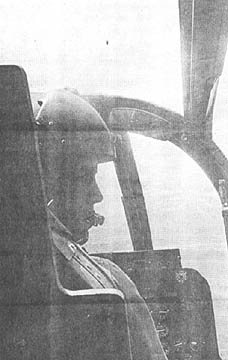 |
|
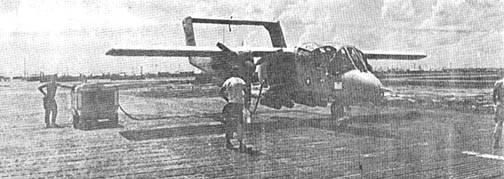 |
| CRANKING UP - After making the final preflight checks and preparations the ground crew stands by while the pilot starts the engines. The OV-10 is a counter-insurgency aircraft capable of carrying five 500-pound bombs. It can also be armed with mini-guns, rockets, grenade launchers and machineguns. |
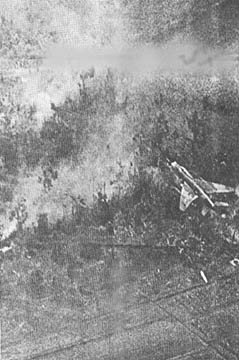 Broncos Doing Their Thing
Broncos Doing Their Thing
Feature SP4 KARL KARLGAARD
CU CHI - Diving in from the
clouds at 200 knots, an Air Force forward air controller (FAC) peers through his
sight at an enemy bunker complex and presses a button on his control stick.
A rocket hurtles toward its
target from a pod underneath the OV-10 "Bronco" and a cloud of smoke billows
up as the marking round explodes.
"Marking round good,"
Captain Robert Twigg of Andover, Mass., radioes to the two F-100 fighter pilots
circling the area.
"Roger," replies the
lead pilot. "Rolling in with a
couple of heavies."
Seconds later, a 25th
Infantry Division infantryman looks up as 25 tons of screaming aircraft tear
through the sky over his head.
A thousand pounds of
steel-encased explosives drop from beneath the Supersabre's wings and
gracefully arch toward the enemy below.
As the bombs detonate, a
tremendous explosion destroys the enemy positions, throwing up clods of earth
and a cloud of smoke. The ground
heaves for several hundred meters around the impact area and settles back again
as the shock waves passes.
The second fighter makes its
pass at the target, and the two planes continue until all their ordnance is
expended. Now nothing remains of
the target area but a jumbled heap of smoldering wreckage.
As the Tropic Lightning
infantrymen lift themselves from their positions and start their sweep forward,
they meet with none of the enemy fire that had greeted them earlier and prompted
the air strikes. Charlie had been
killed or was hastily moving out.
With his part of the mission
accomplished, Twigg continues with a visual reconnaissance.
This is a constant job - at least one FAC is airborne over the 2d
Brigade area of operations all the time during daylight hours.
"We try to cover the whole
Brigade area each day," said Major Hubert Martin, another 2d Brigade FAC from
North Vernon, Ind. "But naturally
we concentrate on areas of heavy enemy activity."
The FACs normally stay close
to any ground unit near suspected enemy positions, but they are never more than
four to five minutes away from any 2d Brigade unit needing help from above.
With very little delay, they
can be placing ordnance on the enemy, filling the time needed for the jets to
scramble and be overhead with their payload.
The 2d Brigade FAC's are
well aware of the infantry's need for close air support, and they provide just
that. Putting on a show of
precision flying while dropping destruction on the enemy is an everyday
occurrence.
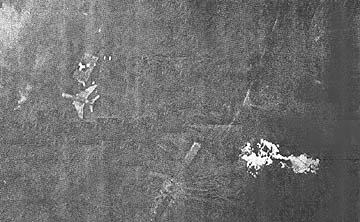 "Outstanding," said
Major Wayne Downing of Peoria, III., 2d Brigade Operations Officer, of the job
done by the Fire Brigade's forward air controllers.
"They do much more than they have to.
They are a very real part of the team."
"Outstanding," said
Major Wayne Downing of Peoria, III., 2d Brigade Operations Officer, of the job
done by the Fire Brigade's forward air controllers.
"They do much more than they have to.
They are a very real part of the team."
Left: STREAKING
out of the targets area, an F-100 jet leaves behind a
mushrooming cloud of smoke and dust. The
forward air controller guided in the strike to support the 1st Battalion
(Mechanized), 5th Infantry, near FSB Stuart.
ON
TARGET
- [Above,
right] Making a low-level bomb run, an Air Force F-100 Supersabre drops
destruction on enemy positions. The
target was marked with a smoke rocket shot from the "Bronco" spotter plane.
|
PRE-FLIGHT CHECK
- As his flight crew makes its final inspection of the
aircraft, Captain Robert Twigg of Andover, Mass., readies himself for the
mission. He personally inspects the
aircraft before boarding it. |
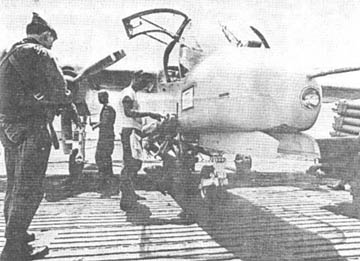 |
Page 6 TROPIC LIGHTNING NEWS August 4, 1969
Tomahawk
4.2 Mortarmen Work Out on Virgin
Mobile Tubes Pound Reds
TAY NINH - The men of the
four-deuce (4.2-in.) mortar platoon of the 4th Battalion (Mechanized), 23d
Infantry, have been keeping their mortar tubes smoking as they carry out fire
missions in War Zone C near Nui Ba Den, the Black Virgin Mountain.
The mortarmen have set high
standards for themselves. Mortar
tubes inside the armored personnel carriers are kept immaculate 24 hours a day.
The men allow themselves 60 seconds to get the first round off when a
fire mission is called in.
"The men really have it
down pat. As soon as I relay the
necessary data for a fire mission they're on those tubes like bees on
honey," said fire direction control's Sergeant Dennis L. Newfer of Wichita,
Kans. "It never takes them the
allotted 60 seconds to send the first round on its way; by the time 45 seconds
have gone by the target has felt the wrath of the four-deuce mortarmen."
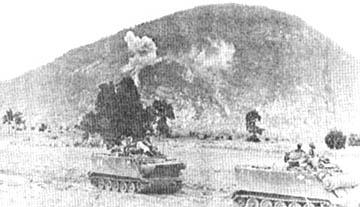 The platoon has four squads:
one fire direction control squad and three gun squads.
The fire direction control squad relays the direction, charge setting and
type of round to use.
The platoon has four squads:
one fire direction control squad and three gun squads.
The fire direction control squad relays the direction, charge setting and
type of round to use.
While in a night defensive
position in the Crescent area, the 4/23 Tomahawks have relied heavily on
four-deuce to supply illumination when needed.
Besides supplying illumination and high explosive rounds the Tropic
Lightning mortarmen have placed riot control agents into suspected enemy base
camps.
FROM THE BASE OF
Nui Ba Den the Tomahawks four-deuce mortar platoon heads for
base comp while eight-inch howitzers bang suspected enemy positions.
(PHOTO BY PFC JOHN FRAME)
Sarge out Of Work?
TAY NINH - Operating 10
miles south of Tay Ninh City, Bravo Company of the 4th Battalion, 9th
Infantry, discovered a large cache containing equipment, clothing, grenades,
small arms, mortars and rice. The
body of an NVA soldier, killed 24 hours earlier, lay on a stretcher beside the
cache.
Bravo Company was on a
patrol in the northern sector of the dense Straight Edge Woods. "We worked our way up to check out a .51 caliber machine
gun position and we saw all kinds of stuff inside and outside the bunker,"
commented Private First Class Lofton Hollomon of Jackson, Tenn.
"There were enough arms and equipment to supply quite a few enemy
operating in the area."
"We must have put some NVA
supply sergeant out of a job," sald Hollomon.
Up Tight Arty's Power Backs Up 3d Brigade Infantrymen
By SP5 RICK ADAMS
CU CHI - M-60 machinegun
fire, blistering .30 caliber mini-guns, mounted grenade launchers and blasting
2.47 rockets make for a wide array of enemy-killing ordnance on helicopters.
But when officers like
Captain Joe Kilbane are aboard, the chopper s' firepower takes on even larger
dimensions. Kilbane is the
artillery liaison Officer for the 3d Brigade, and if you've never looked down
from a circling helicopter as a battery of 105mm howitzers fired, come fly with
him.
THE 29-YEAR-OLD
Bostonian
captain is the constant companion of Colonel William Maddox, brigade commander.
From the mass of radios in the colonel's command and control ship,
Kilbane has continuous communication with his 2d Battalion, 77th
Artillery and all other artillery units, both American and Vietnamese, in the
brigade's area of operations. From
his vantage point above the battling infantrymen, the artillery officer can
direct and co-ordinate massive fire on enemy locations in support of allied
troops.
But the brigade's recent
move to Hau Nghia Province has added new dimensions to his job. "In Dau Tieng where we were before moving, we had a lot of
enemy contact and there was not a big problem in getting firing clearances
because we didn't have a very big civilian population in our area," recalled
Kilbane. "But with the very large
population in this province, plus the active South Vietnamese forces here, we
have to be very sure before we fire a single round of artillery."
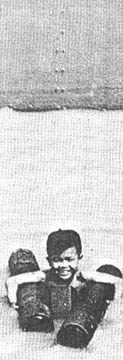 Since arriving in Hau Nghia,
Kilbane has spent many hours in conferences with Vietnamese artillery people.
"My big job now is to get everyone involved - to get them talking in
artillery terms," He says.
Since arriving in Hau Nghia,
Kilbane has spent many hours in conferences with Vietnamese artillery people.
"My big job now is to get everyone involved - to get them talking in
artillery terms," He says.
"One of the brigade's
most important missions is developing and improving the Vietnamese infantry
units here. Colonel Maddox and
Lieutenant Colonel Lewis W. Wright, 2d Battalion, 77th Artillery,
commander, have decided to place the same importance on ARVN artillery," he
added.
A FIRING TEAM
and an
interpreter from 2/77th have recently begun to visit ARVN artillery
units with Kilbane. The team is
providing hard-to-get technical knowledge.
Since Kilbane began using
ARVN artillery in direct support of American units, their confidence has grown.
"When we run into problems, we correct them.
When they don't have the proper equipment, we supply it," Kilbane
said.
The constant liaison work
means that the many combined infantry operations in the province soon will be
supported by combined artillery fire. As
that invaluable helicopter flies above ground troops, its ability to supply
massive artillery fire has now become allied firepower.
VIETNAMESE WATER WINGS
- What does a boy do with two empty 105mm ammo filters
and an empty fuse can? This
youngster found a good use for them as he enjoys a dip in the Song Vam Co River
just south of Tay Ninh City. (PHOTO
BY SP4 PETE FREEMAN)
Page 7 TROPIC LIGHTNING NEWS August 4, 1969
 |
| PZ - Bravo Company runs for an eagle flight to take them from the Renegade Woods to the Straight Edge Woods. After assaulting the woodline they will wait for the CIDG to join them. |
| OFF THEY GO - These men of the CIDG charge off their choppers during operations in the Renegade Woods. | 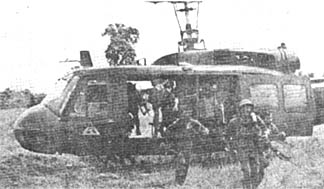 |
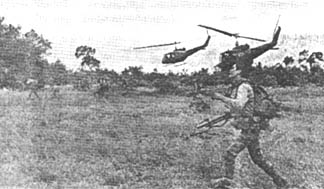 |
LZ - Members of the CIDG scramble off helicopters and run for the cover of the woodline. |
All
Vietnamese Join in Defense of Fatherland
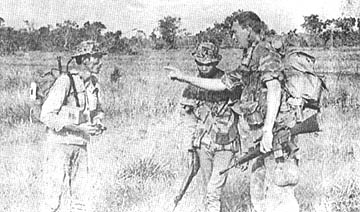 TAY NINH - In the first
action of its kind, men of Bravo Company, 4th Battalion, 9th Infantry, combined
efforts with the Vietnamese Civilian Irregular Defense Group (CIDG) in the area
to spend three days and nights combing the southern edge of the Renegade Woods
south of Tay Ninh City.
TAY NINH - In the first
action of its kind, men of Bravo Company, 4th Battalion, 9th Infantry, combined
efforts with the Vietnamese Civilian Irregular Defense Group (CIDG) in the area
to spend three days and nights combing the southern edge of the Renegade Woods
south of Tay Ninh City.
The CIDG is made up entirely
of volunteers who wish to rid their area of Viet Cong and North Vietnamese
infiltrators. They have no time
obligation and can quit whenever they want.
The 4/9 Manchus gained new respect for the CIDG during the three day
operation.
On the first day, Bravo
Company and the CIDG went by eagle flight to the edge of the woods.
The first lift assaulted the thick woodline.
From there the Manchus and Vietnamese soldiers chopped their way through
heavy jungle to their rendezvous point.
Six ambush patrols were sent
out each night, one from the Manchus, one from the CIDG, and four combined
groups. Soon after the ambush
patrols had gone out the second night, Viet Cong moved in and tried to surround
the combined command post. Captain
Hai of the CIDG went out with four of his men to gain reconnaissance information
on enemy locations and strength. At
least a platoon dug-in and "ready to fight" was reported by Hai.
Artillery
forward observer First Lieutenant Don Bradley of Peoria, Ill., dropped artillery
to within 100 yards of the command post on information given him by the CIDG
commander.
"I knew it was close so l
told everyone to stay low and then I put it right where the Vietnamese had
spotted the enemy," said Bradley. The
allied troops found dug-in enemy positions the next morning right where the
artillery had landed. The enemy had
been driven off.
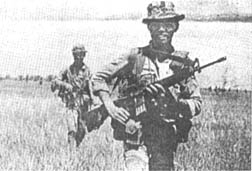 Captain Ronald J Cabral of
Fall River, Mass, commanding officer of Bravo Company had high praise for his
CIDG allies. "They were about as
aggressive as any group over here," he said.
"During the three-day operation they would go out of their way to make
contact."
Captain Ronald J Cabral of
Fall River, Mass, commanding officer of Bravo Company had high praise for his
CIDG allies. "They were about as
aggressive as any group over here," he said.
"During the three-day operation they would go out of their way to make
contact."
"It really gives you a
good feeling to see these Vietnamese beside you day and night; it really makes
you see that the people are with you, because you know they are volunteers,"
added Staff Sergeant Leonard V. Simpson of Antioch, Calif., platoon leader for
Bravo Company.
HUMPING - CIDG
infantrymen move out with weapons ready as they approach a
suspected enemy-infested woodline. [Above, left]
GO THIS WAY
- A Green Beret adviser to the CIDG troops gives his unit last words
of advice before they enter the Straight Edge Woods heading for their night
ambush position with Bravo Company, 4th Battalion, 9th Infantry Manchus. [Above,
right]
|
Feature By PFC Richard Sears |
Page 8 TROPIC LIGHTNING NEWS August 4, 1969
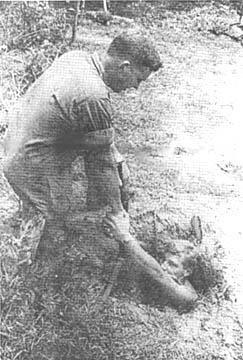 CU CHI - Speed, mobility,
and surprise are elements that make an infantry unit a powerful striking force
against its enemy. Wolfhound
infantrymen of the 2d Battalion, 27th Infantry, are working in joint operation
with ARVN, Regional and Popular Forces in the III Corps area, 30 miles northwest
of Saigon. The Tropic Lightning 3d
Brigade troopers are teaching their allies operational tactics which have made
the Wolfhounds a potent fighting unit.
CU CHI - Speed, mobility,
and surprise are elements that make an infantry unit a powerful striking force
against its enemy. Wolfhound
infantrymen of the 2d Battalion, 27th Infantry, are working in joint operation
with ARVN, Regional and Popular Forces in the III Corps area, 30 miles northwest
of Saigon. The Tropic Lightning 3d
Brigade troopers are teaching their allies operational tactics which have made
the Wolfhounds a potent fighting unit.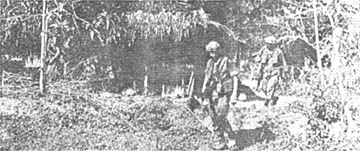 Lewis states, "This
project is helping to establish a better working relationship between the allied
forces. The two working together
have valuable experience to gain from each other."
Lewis states, "This
project is helping to establish a better working relationship between the allied
forces. The two working together
have valuable experience to gain from each other."
Partners Own Monopoly on Victory
By SP5 RICK ADAMS
CU CHI - A monopoly has been
formed in Hau Nghia Province, and anti-trust laws don't apply since the 3d
Brigade and South Vietnamese forces are creating a monopoly aimed at driving
enemy soldiers from this border province.
The brigade, recently moved
to the province, is making it a full partnership with its forward headquarters
located among the government and military centers at Bao Trai, Hau Nghia's
capital.
LIVING TOGETHER alleviates
the many problems of constant coordination and communication necessary for a
smooth and successful alliance
Daily combined American and
Vietnamese combat operations are paralleled by daily, joint briefings and
planning sessions. The brigade
maintains liaison officers at the 25th ARVN Division headquarters, the 49th ARVN
Infantry Regiment and two district headquarters.
Field locations are also
shared by American and Vietnamese battalions.
"We have three main objectives in Hau Nghia Province - engage main
force enemy units, support pacification and improve ARVN capabilities," said
Colonel William Maddox, the brigade commander, from Newburgh, N.Y.
"By working with the Vietnamese forces on a daily basis, we are
accomplishing all three objectives."
"POLITICALLY, THE Vietnam
situation is much more stable. They
have held elections from the local hamlet to the national level, and security is
the key to these successes," stated Maddox.
"The big battles that have
been fought for this improved security and those that we will fight in the
future have instilled confidence in the Army and loyalty in the population.
There is great hope for the future in Hau Nghia Province."
Colonel Maddox concluded,
"A good military capability for any force is based on accepted military
doctrine and tradition. Success on
the battlefield has given sufficient training and education and additional time
for South Vietnamese units to develop their doctrines and traditions."
Division Artillery Has New Commander
By SP4 KEN FAIRMAN
CU CHI - Colonel John S.
Wieringa Jr. turned over command of the 25th Infantry Division Artillery to
Colonel Dan D. Stedham in a change of command ceremony July 24.
Major General Ellis W.
Williamson, Commanding General of the 25th Infantry Division awarded Wieringa
the Legion of Merit during the ceremony.
STEDHAM CAME to DIVARTY
after serving as 9th Infantry Division Artillery Commander at Dong Tam. Prior to
coming to the 9th DIVARTY, he was assistant chief of staff, G-4, for I Field
Force headquarters in Nha Trang.
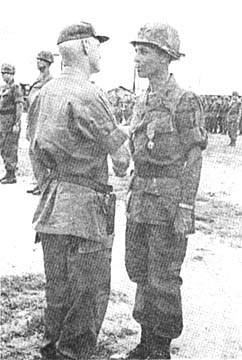 Stedham, 41, from El Paso,
Texas, was graduated from Texas A&M College in 1949, earning an ROTC
commission. He is a graduate of
both the Army Command and General Staff College at Fort Leavenworth, Kan., and
the War College in Washington, D.C. He
has had command and staff experience at both the battery and battalion level.
Stedham, 41, from El Paso,
Texas, was graduated from Texas A&M College in 1949, earning an ROTC
commission. He is a graduate of
both the Army Command and General Staff College at Fort Leavenworth, Kan., and
the War College in Washington, D.C. He
has had command and staff experience at both the battery and battalion level.
His previous commands
include duty as a battery commander for the 867th AAA Battalion in Alaska and as
battalion commander for the 3d Battalion, 17th Artillery, as well as service in
Korea during the conflict.
WIERINGA TOOK command of
DIVARTY in February and coordinated fire support of allied units in the III
corps area.
Wieringa, a West Point
graduate commissioned in 1946, has served in Korea as Battalion Executive
Officer and Battalion S-3. From
June 1963 to January 1965 he was battalion commander in the 319th Arty, 173d
Airborne Brigade. Prior to arrival
in DIVARTY, he served as Chief, Personnel Services Division, G-l, USARV.
After a leave, Wieringa will
be stationed at the Pentagon.
LEGION OF MERIT - Major General Ellis W. Williamson awards the Legion of Merit
and gives a hearty handshake to Colonel John S. Wieringa Jr.
(PHOTO BY SP4 KEN FAIRMAN)
3/4 Horsemen Don't Get Their Cool Blown Away
By PFC VICTOR ALLISON
Mines and booby traps remain
a very real danger for the men of the 3/4 Cav.
As Charlie's bunkers and tunnels collapse from weather and constant
pounding from the McKenziemen, the Cav has to sweep through heavily mined areas
that once were Charlie's domain.
Captain Donald E. Appler of
Huntsville, Ala., commanding Officer of Charlie Troop 3/4 Cav, instructed his
men to "check out everything" as they prepared to sweep on the fringe of the
Boi Loi Woods.
Words of caution such as
those needn't be issued twice. The
men of the Cav are fully aware of the dangers in the field.
Before the sweep was 10
minutes old a mine was discovered. C-4
explosive was applied and about 10 minutes later the mine exploded, failing its
intended function.
Not only are enemy mines and
booby traps hazards to the sweeping horsemen; they also have to worry about dud
rounds. But, with a lot of caution
and a little C-4 the duds are handled in the same way as the mines and booby
traps.
Thanks to
Ron Leonard, 25th Aviation Bn., for locating and mailing this issue,
Kirk Ramsey, 2nd Bn., 14th Inf. for creating this page.
This page last modified 8-12-2004
©2004 25th Infantry Division Association. All rights reserved.